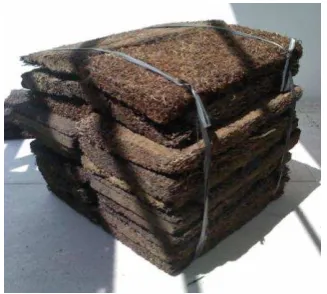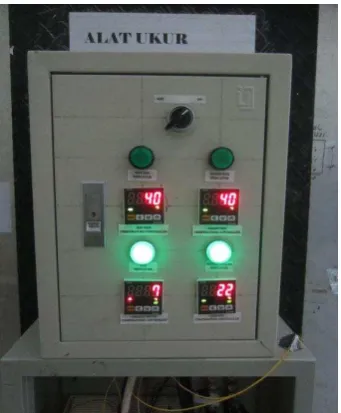ACHIEVING PAKIS’S THERMAL CONDUCTIVITY AS
ARCHITECTURAL BUILDING THERMAL RESISTANT BY GUARDED
STEADY-STATE HOTBOX METHOD:PART 1
Danny Santoso Mintorogo1,a and Mohd. Hamdan Ahmad2,b 1
Petra Christian University, Department of Architecture, Surabaya-Indonesia
2Universiti Teknologi Malaysia, Institut Sultan Iskandar, Johor Bahru-Malaysia
Email: [email protected], [email protected]
ABSTRACT
Thermal conductivity of various materials which are mostly listed available as building or industrial materials in reference books and websites; but one will hardly find out for every new material, and has to be observed and try out itself if we want to know the new thermal conductivity value (k). Nonetheless with new substanct likes pakis-stem blocks that come from natural tree that could be found in the tropical woodland of Indonesia. Steady-state homogeneous temperature applied with hotbox method in an uninfluent environment likes guarded laboratory environment is the right method to obtain the thermal conductivity and resistance of porousness and semi-solidness of the pakis-stem blocks. After investigating almost 24 hours with controller TRSYS01 applying with ASTM C1155, physical semi-solid pakis blocks tend to be more easy to obtain the R-value, k-value, and surface temperatures than the porous pakis. The porous pakis blocks were tend to unstable during the test due to its physical permeable condition. The resistant values (R-value) and thermal conductivity (k) values will be further published on the following discussion of pakis thermal conductivity part 2.
Keywords: Pakis, Thermal conductivity, Building thermal resistance, Steady-state Hotbox.
INTRODUCTION
Pakis trees are growth and can be found in tropical rain forest in hot and humid climate. A lot of
flourish stores loves to sell pakis’s blocks that come from cutting of the pakis’s stem. People use pakis
blocks for orchid flower medium and interior docora-tion elements. Other fucdocora-tions of the pakis blocks are being researched as new building material as outer thermal heat insulation on flat bare concrete rooftop systems. Scientific arithmetical equation to calculate the global heat solar radiation and sol-air thermal heat passing through a piece of concrete rooftop material need to be acquainted with pakis’s thermal conduc
-tivity values. Pakis’s thermal conductifity (k) is totally new value to search and un-listed in the well-known thermal conductivity tables, journals and web-based papers in the world. Thermal conductivity measure-ment can be measured in a number of possible ways that depand on chemical composition, porosity, density, structure and fabric of the materials as well as the accessible equipment. The equipment are avai-lable with hot-wire and guarded hotbox method. Measurement methods are depend on the physical materials. According to Alfata (2012) measurent with hot wire method is suitable for homogeneous solid materials likes brick and concrete block; meanwhile pakis blocks are porous and semi-solid materials in general that are less homogeny stage. The more suitable method for measuring pakis materials (porous and semi-solid) is using guarded hotbox methodology means.
LITERATURE REVIEWS
Steady-state techniques are constructive to apply whilst the temperature of the material does not change with time. This makes the signal measurement in straightforward condition (steady state implies con-stant signals). In common steady-state techniques apply to material with continuous temperature, and monitoring continuously the temperature acrossed the materials till becomes steady eventually; it is usually undertake 4 to 12 hours. The disadvantages of this method are well-trained laboratory-engineers needed and lot of working-time requisite to the stage of equilibrium (wikipedia encyclopedia, 2012).
There is a dissimilarity between steady-state and transient techniques. If the value of thermal conduc-tivity is needed right away then a transient heating method could be performed to an isotropic material with constant heating power applied. If there are more complexity conductions of thermal conductivity on various kinds of materials likes solids, powder, liquid, paste and thin film then transient plane source method could be used to sensor a plane of an istrotropic and unisotropic materials. Transient plane can do sensor by using a flat sensor with double spiral of electrically conducting Nikel (Ni) metal that etching out of thin foil and clad to conduct two pieces of the same sample or single sided at the same time.Trancient line source method conducts measurements mostly by
series of needle probes. Searle’s bar method is applied
to good conductors of heat ((http://media paisley.ac.
uk), and for poor conducors of heat can be used Lees’
In conducting measurement on gas argon, two methods, steady-state and transient, have been applied by hot-wire system (Roder et al., 2000). The relative uncertainty of argon at 95% of confidence level is smaller 1% by transient method than steady-state method. Meaning that the steady-state method is more likely to harmonize normal transient measurements at low densities level. Other measurements have also been conducted to obtain thermal conductivity with cylindrical probe. (Vacquire 1985; Kristiansen 1982).
Based on studied by Blum (1997), thermal con-ductivity coefficient, k {W/(m.k)}, is the measured of thermal q (W) that heat flux is passing through a material by state of the art steady-state temperature difference (T2-T1) in excess of distance (x2-x1);
expressed in general equation: q = k (T/x).
METHODOLOGY
There are two types of measurements could be done on the pakis; one is by hot-wire method to which one-side of the pakis is heated up locally by electrical hot-wire then the loss-heat-flux passed through the pakis is measuared to obtain as k value. Conducted heat through pakis and heat loss by air inside the porous-pakis could not be measured absolutely. Due to pakis is porous and semi-solid material not a perfect-solid one likes concrete or brick material, the homogeneous hot air is needed instead of localization heated area by hot-wire method.
Setting up the Equipment
The steady-state hotbox method is controlled by controller TRSYS01 applying with ASTM C1155 (Standard Practice for Determining Thermal Resis-tance of Building Envelope Components from the in-situ Data). The measurements are taking place in an enclosed environment laboratory with a constant temperature; the equipment are one set of thermo-couple sensor TC11 and TC21 placing in hotbox and TC12 and TC22 placing in coldbox). Another two units of heat flux transducer sensor (HF01 and HF02) are attaching to measure the heat flux flow across the pakis in coldbox ((Fig.1, 2, 3 & 4).
The hotbox measurement size has a dimension of 1.6 m x 1.6 m. In order to prevent hot air penetrating through the pakis panel of 1 m x 1 m to coldbox sphere, extra styrofoam panels are attaching around the pakis panel, and the gap is then sealed with aluminum foil (fig. 5).
Setting up the Pakis Material
Pakis is unique material; the stems are cut into square blocks, and have a characteristic of porous and semi-solid physical condition. There are two types of
pakis blocks sold in the flower markets; small blocks have dimension of 240 mm length x 120 mm width x32 mm height, and the large blocks are around 350 mm x 180 x 32 mm (Fig. 6). Pakis-stem blocks are sold commonly in a bundle of 20 blocks and in mixing of porous, semi-solid blocks.
Source: Lasino
Figure 1. Guarded Hotbox Equipments with Thermocouple
& heat flux transducer sensors [TC:thermocouple; HF:heat flux transducer]
Figure 2. Controller & Hotbox
Figure 3. Hoxbox in Guarded Laboratory Environment for
Figure 4. Attaching Thermocouples & Heat Flux
Figure 5. Placing Pakis Panel 1m x 1m at hotbox
Figure 6. Two Pakis dimensions; (A). Small and porous;
(B). Large and semi-solid
Scientific notes on specimen test (two large pakis blocks):
Areas of two pakis-blocks : 1,225 cm2
Volume : 4,103.75 cm3
Mass : 1,406.10 gram
Density : 0.343 gram/cm3
Figure 7. Pakis Blocks sold in the Market
Figure 8. Attaching Pakis Blocks to Styrofoam
Figure 9. Placing Pakis-Styrofoam Panel to Woodden
Hotbox Frame
PROSEDURE
After the pakis-styrofoam-woodden frame attching to hot-box equipment (fig.10), all boxes (hot and cold) are closed tightly to prevent hot air outflow to guarded box (laboratory environment)(fig. 2 & 3). Steady-state heating techniques are to be applied to two pakis blocks on styrofoam panel for 4 to 6 hours till the heat flux becoming steady in cold domain. The tempera-ture in the hot-box sphere is set to 40oC and 18oC in the cold-box sphere; so there is 22oC temperature difference to driven enough the hot air piercing through the pakis blocks (fig. 11). No hot air will penetrate through the pakis-styrofoam panel due to its thermal characteristic of insulation. The styrofoam panel has also been tested for fire resistance rating to put off mealting state. The measurement will be recorded every 10 minutes to the controller, and all the data will be accumulated with Loggemet software made from Campbell Scientific.
Figure 10. Pakis-styrofoam panel 1.00 x 1.00 m
Figure 11. Temperature Controller running on Hotbox
Equipment
PROBLEMS ENCOUNTERED
When accomplishment of initial measurement with Pakis-styrofoam panel of 1.00 m x 1.00 m attching to guarded hotbox (fig. 10), the cold-air in coldbox sphere was infected with such hot air that coming from boundaries of Pakis-styrofoam panel in hotbox sphere. Problem is secured by expanding the pakis-styrofoam to full size of 1.60 x 1.60 m (fig.6).
Another problem encountered to measure of pakis blocks is when dealing with the types of pakis whether porous or solid materials. The semi-solid pakis blocks demonstrated its thermal charac-teristic of heat flux taking place constantly at 5 to 6 hours, nevertheless the porous pakis established unsteady state of thermal distinctive heat flux to almost 23 hours. The physical porousness of pakis— many small stalks in the blocks and surrounded air inside the porous blocks makes happen the heat flowing to heat flux probes directly in the coldbox sphere without passing thru the pakis blocks. As a result the heat fluxes accumulated eventually.
Lastly, the outcome of the pakis-porousness blocks thermal conductivity values are mathematical scheme with consideration of convergency factor of CR1<0<0.10.
Acknowledgments
I personally enthusiastically thank you to Mr. Muhammad Nurfajri Alfata and his engineering team for their hard-working techniques and efforts to make the experiment done. My appreciation is as well to Faculty of Planning and Engineering, Petra Christian University, for the supporting of experimental finan-cial. Finally, my appreciatively thanks is going to my academic advisor, prof. Mohd. Hamdan Ahmad for his endless supports and advises
REFERENCES
Alfata, M.N. (2012). Thenical Corresponding Email-Notes. March-April.
Blum, P. (1997). Physical Properties Handbook: A guide to the shipboard measurement of physical properties of deep-sea cores, ODP Tech. Texas A&M University. pp. 8-1.
Kristiansen, J.I. (1982). The Transient Cylindrical Probe Method for Determination of Thermal Para-meters of Earth Materials. Volume 18:154. Aarhus, Denmark
Roder, H.M., Perkin, R.A., de Castro, C.A.N. & Laesecke, A. (2000). Absolute Steady-State Thermal Conductivity Measurements by Use of a Transient Hot-Wire System. Journal of Research of National Institute of Standards and Technology 105.
Vacquire, V. (1985). Oil Fields: A Source of Heat Flow. Tectonophysics103: 81-98
Information on website: http://en.wikipedia.org/wiki/ Thermal conductivity measurement
![Figure 1. Guarded Hotbox Equipments with Thermocouple & heat flux transducer sensors [TC:thermocouple; HF:heat flux transducer]](https://thumb-ap.123doks.com/thumbv2/123dok/3652142.1465863/2.595.292.510.590.736/figure-guarded-hotbox-equipments-thermocouple-transducer-thermocouple-transducer.webp)

